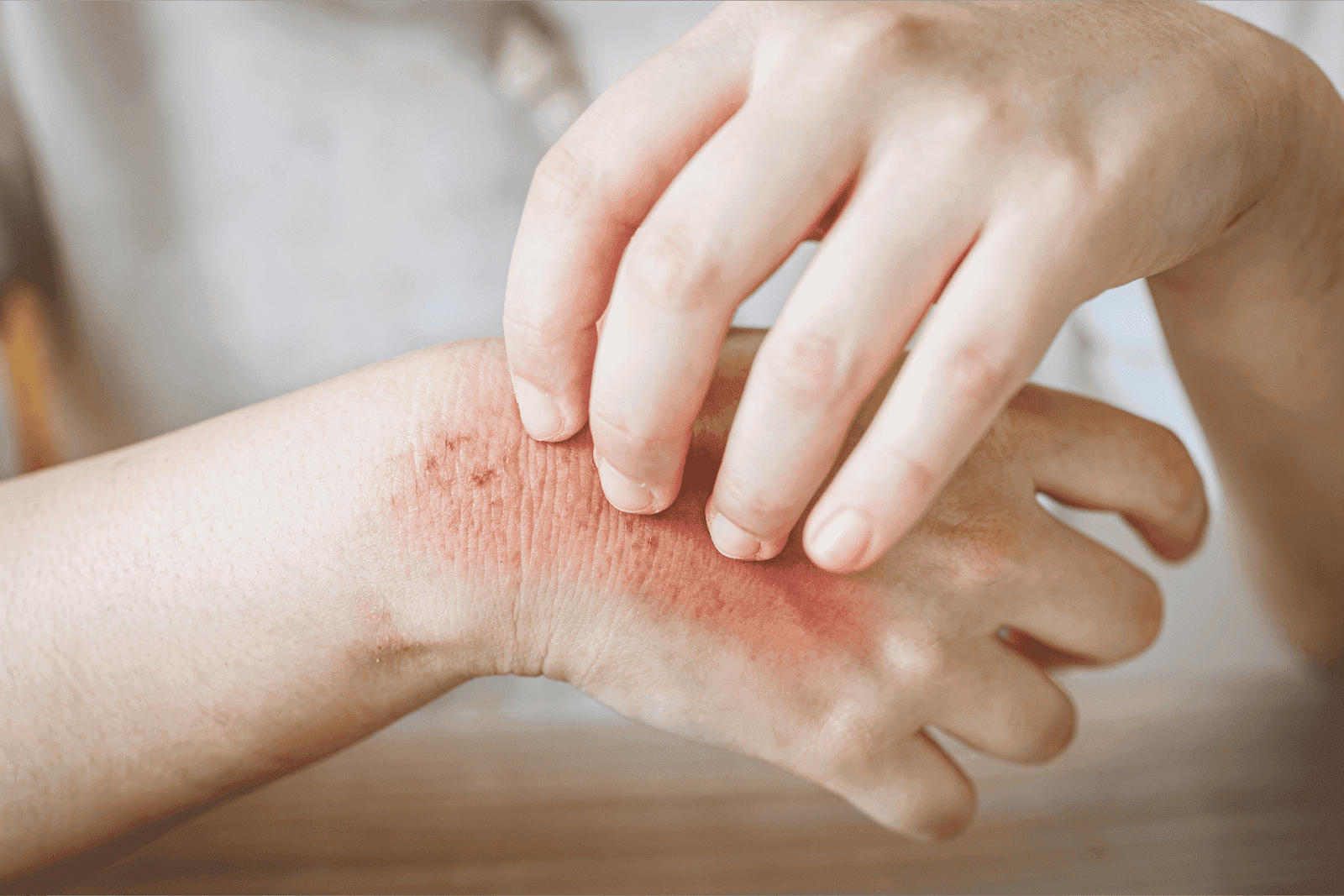Zepbound and Nausea - How to Manage It
Key TakeawaysZepbound (tirzepatide) is an FDA-approved medication for chronic weight management and improving obstructive sleep apnea through weight loss.Nausea is a common [...]
Read More
Medically reviewed by Abhijit Bhattacharyya | MD, PhD, MBA, Tufts University School of Medicine - Miami, Florida on August 16th, 2025.
Rashes are one of the most common skin complaints, affecting people of all ages and backgrounds. They can appear suddenly or develop over time, and their causes range from harmless irritations to serious medical conditions. Understanding what’s causing your rash is crucial to managing it effectively and knowing when to seek professional care. This comprehensive guide will walk you through the common types of rashes, their potential causes, and how modern telehealth service Doctronic.ai can help you get fast, accurate, and personalized medical advice from the comfort of your home.
 Understanding Rashes: What Are They and Why Do They Occur?
Understanding Rashes: What Are They and Why Do They Occur?A rash is essentially a change in the skin’s color, texture, or appearance, often accompanied by itching, redness, swelling, or bumps. Rashes can be localized to one area or spread across large parts of the body. They are a symptom rather than a disease themselves, signaling an underlying issue.
The causes of rashes are diverse. They can result from infections, allergic reactions, chronic skin conditions, environmental factors, or even systemic diseases. Some rashes are mild and resolve on their own, while others require medical intervention.
Recognizing the nature of your rash and its associated symptoms is the first step in determining the cause and appropriate treatment.
Besides the visible changes on the skin, rashes may come with other symptoms such as:
Itching or burning sensation
Swelling or tenderness
Blisters or oozing
Fever or chills (in case of infection)
Joint pain or fatigue (in systemic conditions)
Noting these symptoms can help healthcare providers make an accurate diagnosis.
In addition to these common symptoms, rashes can also manifest in various forms, such as patches, plaques, or hives, each indicating different underlying causes. For instance, hives, which are raised welts on the skin, often arise from allergic reactions to foods, medications, or insect stings. Conversely, psoriasis may present as thick, red patches covered with silvery scales, indicating a chronic autoimmune condition that requires long-term management. Understanding the specific characteristics of a rash can be crucial in guiding treatment options and lifestyle adjustments.
Moreover, the location of the rash can provide valuable clues to its origin. Rashes that occur in skin folds, such as underarms or groin areas, may suggest a fungal infection like candida, while rashes on the face could indicate contact dermatitis or acne. Environmental factors, such as exposure to irritants or allergens, can also play a significant role in the development of rashes. Keeping a detailed record of any recent changes in products used, dietary habits, or environmental exposures can assist healthcare professionals in pinpointing the cause more effectively.
Rashes come in many forms, and identifying their characteristics can narrow down potential causes. Below are some of the most frequently encountered types of rashes and what they might indicate.
Contact dermatitis occurs when the skin reacts to an irritant or allergen. This rash typically appears as red, itchy patches or blisters where the skin came into contact with the offending substance.
Common triggers include soaps, detergents, poison ivy, nickel jewelry, and certain cosmetics. The rash usually develops within hours or days after exposure and improves once the irritant is removed.
Eczema is a chronic condition characterized by dry, itchy, inflamed skin. It often affects children but can persist into adulthood. The rash may appear as red or brownish-gray patches, sometimes with small bumps that can leak fluid when scratched.
While the exact cause is unknown, eczema is linked to genetic factors and an overactive immune response to environmental triggers such as allergens, irritants, and stress.
Psoriasis is an autoimmune condition that causes skin cells to multiply rapidly, leading to thick, scaly patches that are often itchy or painful. These patches commonly appear on the scalp, elbows, knees, and lower back.
Triggers include infections, stress, cold weather, and certain medications. Psoriasis can also be associated with joint inflammation, known as psoriatic arthritis.
Fungal infections like ringworm or athlete’s foot cause rashes that are typically red, circular, and itchy. These infections thrive in warm, moist environments and are contagious.
Proper hygiene and antifungal treatments are essential for managing these rashes.
Many viral infections cause rashes, including measles, chickenpox, and shingles. These rashes often come with systemic symptoms such as fever, fatigue, and body aches.
Viral rashes can be widespread and vary in appearance, from flat red spots to raised bumps or blisters.
Heat rash occurs when sweat ducts become blocked, trapping sweat under the skin. It appears as small, red bumps or blisters, often in areas where skin folds or clothing causes friction.
This rash is common in hot, humid weather and usually resolves with cooling and avoiding excessive sweating.
Many rashes are benign and resolve with simple home care, but some require prompt medical attention. It’s important to recognize warning signs that indicate a more serious problem.
Rash accompanied by high fever, chills, or severe pain
Rapidly spreading rash or one that looks like bruising or purple spots
Swelling of the face or difficulty breathing
Blisters or open sores that ooze pus
Rash following a tick bite or exposure to poison ivy/oak
Rash that does not improve or worsens after a few days of home treatment
If you experience any of these symptoms, it’s crucial to seek medical care immediately.
In today’s digital age, telehealth services offer a convenient and efficient way to get medical advice for rashes without leaving your home. Doctronic.ai provides access to AI-powered primary care that synthesizes the latest medical research to deliver fast, accurate diagnoses and treatment recommendations.
Doctronic’s AI doctor can analyze your symptoms, ask targeted questions, and provide a comprehensive assessment within seconds. For more complex cases, you can also schedule affordable video visits with licensed doctors available 24/7 across all 50 states. This approach ensures you get personalized care that remembers your medical history and preferences, making follow-up easier and more effective.
While professional evaluation is ideal, there are steps you can take to better understand your rash before consulting a healthcare provider.
Note the color, size, shape, and texture of the rash. Is it flat or raised? Are there blisters, scales, or crusts? Does it appear in one area or multiple sites?
Think about new products you’ve used, such as soaps, lotions, or detergents. Recall any outdoor activities that might have exposed you to plants like poison ivy or insect bites.
Keep a record of any itching, pain, fever, or other systemic symptoms. Note if the rash worsens with heat, cold, or certain activities.
Some rashes are linked to chronic conditions like eczema or psoriasis. Consider whether you have a history of allergies or autoimmune diseases.
Gathering this information can help your healthcare provider make a more accurate diagnosis, especially during telehealth consultations.
Treatment varies widely depending on the cause of the rash. Here are general approaches for some common types:
Avoid the irritant or allergen causing the rash. Use gentle skin cleansers and moisturizers. Over-the-counter hydrocortisone creams can reduce inflammation and itching.
Maintain skin hydration with emollients and avoid known triggers. Prescription topical steroids or other medications may be necessary for flare-ups.
Topical treatments like corticosteroids, vitamin D analogs, and moisturizers help manage symptoms. In severe cases, systemic medications or biologics may be prescribed.
Antifungal creams, powders, or oral medications are effective. Keeping the affected area clean and dry is essential.
Treatment focuses on symptom relief, such as antihistamines for itching and fever reducers. Some viral infections may require antiviral medications.
Keep the skin cool and dry. Wear loose clothing and avoid excessive heat exposure.
For any rash that does not improve with home treatment or worsens, consulting a healthcare professional is recommended. Doctronic.ai provides a quick and accessible way to get expert advice and treatment plans tailored to your needs.
Doctronic.ai stands out as a revolutionary AI-powered telehealth platform that transforms how patients access primary care. Here’s why it’s an excellent choice if you’re dealing with a rash or any other health concern:
Instant AI Doctor Visits: Get a comprehensive, evidence-based diagnosis in seconds, drawing on the latest peer-reviewed medical research.
Personalized Care: The AI remembers your medical history and preferences, providing tailored advice every time you visit.
Affordable Telehealth Video Visits: Access licensed doctors 24/7 for under $40, no matter where you live in the U.S.
Trusted by Millions: Over 10 million people have used Doctronic’s services, with rapid growth reflecting high patient satisfaction.
Whether you need a quick second opinion or ongoing care for chronic skin conditions, Doctronic.ai offers a smart, fast, and personal healthcare experience.
 Preventing Rashes: Tips for Healthy Skin
Preventing Rashes: Tips for Healthy SkinPrevention is always better than a cure. Taking care of your skin can reduce the risk of developing rashes and other skin problems.
Maintain Good Hygiene: Regularly wash your skin with mild soap and water, especially after sweating or exposure to irritants.
Moisturize: Use fragrance-free moisturizers to keep your skin hydrated and prevent dryness.
Avoid Known Allergens: Identify and steer clear of substances that trigger allergic reactions.
Wear Protective Clothing: When outdoors, wear long sleeves and pants to minimize exposure to plants, insects, and sun.
Manage Stress: Stress can exacerbate skin conditions like eczema and psoriasis, so practicing relaxation techniques can help.
Stay Cool and Dry: In hot weather, avoid excessive sweating and wear breathable fabrics to prevent heat rash.
Rashes can be unsettling, but understanding their causes and knowing when to seek care can make a significant difference in your health and comfort. From common irritations like contact dermatitis to more complex conditions such as psoriasis or viral infections, accurate diagnosis is key.
Thanks to advances in telehealth technology, Doctronic.ai offers a convenient, affordable, and personalized way to get expert medical advice on rashes and other health concerns. Whether you need a quick AI assessment or a video visit with a licensed doctor, Doctronic.ai is revolutionizing access to primary care with cutting-edge AI and compassionate service.
If you’re facing a rash today, don’t wait and take advantage of modern telehealth solutions to get the care you deserve, right at your fingertips.
Don't let skin rashes disrupt your life. With Doctronic, you get immediate, free access to the #1 AI Doctor, ready to diagnose and offer treatment advice for your rash in seconds. Experience the most personal, AI-powered primary care that's always available, 24/7, in all 50 states. For a more in-depth consultation, our telehealth video visits are just a click away, providing affordable care under $40. Skip the line. Talk to an AI Doctor Now, for free.
Key TakeawaysZepbound (tirzepatide) is an FDA-approved medication for chronic weight management and improving obstructive sleep apnea through weight loss.Nausea is a common [...]
Read MoreKey TakeawaysZepbound (tirzepatide) is an FDA-approved medication primarily for weight management and improving obstructive sleep apnea by reducing body fat.Diarrhea is a [...]
Read MoreKey TakeawaysZepbound (tirzepatide) is an FDA-approved medication primarily for weight management and improving obstructive sleep apnea through weight loss.It works by [...]
Read More